No Till Farming: Upper Brandon uses exclusively no-till farming practices utilizing the latest in planting technology. In the past, farmers actively cultivated the fields, turning the soil and disking until there was essentially a bare dirt seed bed. With no-till farming practices, new seed is planted through remaining cover, eliminating mechanical soil modification. Thus, no-till farming practices vastly reduce/eliminate erosion concerns and soil degradation. No-till farming also allows for better wildlife cover during critical times of the year.
Precision Application: In conjunction with no-till farming, the latest planting technologies dose each seed with measured, critical initial fertilizer. This reduces over nutrification of the soils and ultimately works to prevent excess nutrient run-off, protecting our streams and rivers.
Buffer Strips: Along with precision application, Upper Brandon utilizes an additional layer of protection to protect our vital waterways. Upper Brandon has 100-foot buffer strips in any areas that are adjacent to the James River. These buffer strips are protected throughout the growing season and only maintained once a year. They also provide excellent cover for nesting birds and small mammals.
Cover Crop: Upper Brandon, through Engel Family Farms, participates in the federal program to promote cover crops in order to protect the Chesapeake Bay. Just prior to harvest, we will “fly on” a cover crop seed tailored for our region. As the harvest ensues and the combine mulches the refuse crop, the cover crop seed germinates to stabilize the soils. Most importantly, the cover crop uses any excess nitrogen in the soils to grow, acting like a storage vessel for the winter months. In the very early spring, the cover will be sprayed prior to planting, and the nutrients will be released back into the soil for use by the summer crop. Reducing excess nitrogen run-off is critical to the Chesapeake Bay achieving its TMDL, or total maximum daily load, which is the amount of nutrients that can safely flow to the Bay and be naturally processed in any given day. A collateral benefit to our cover crop is that it provides an excellent food source for migratory birds during the winter months.

